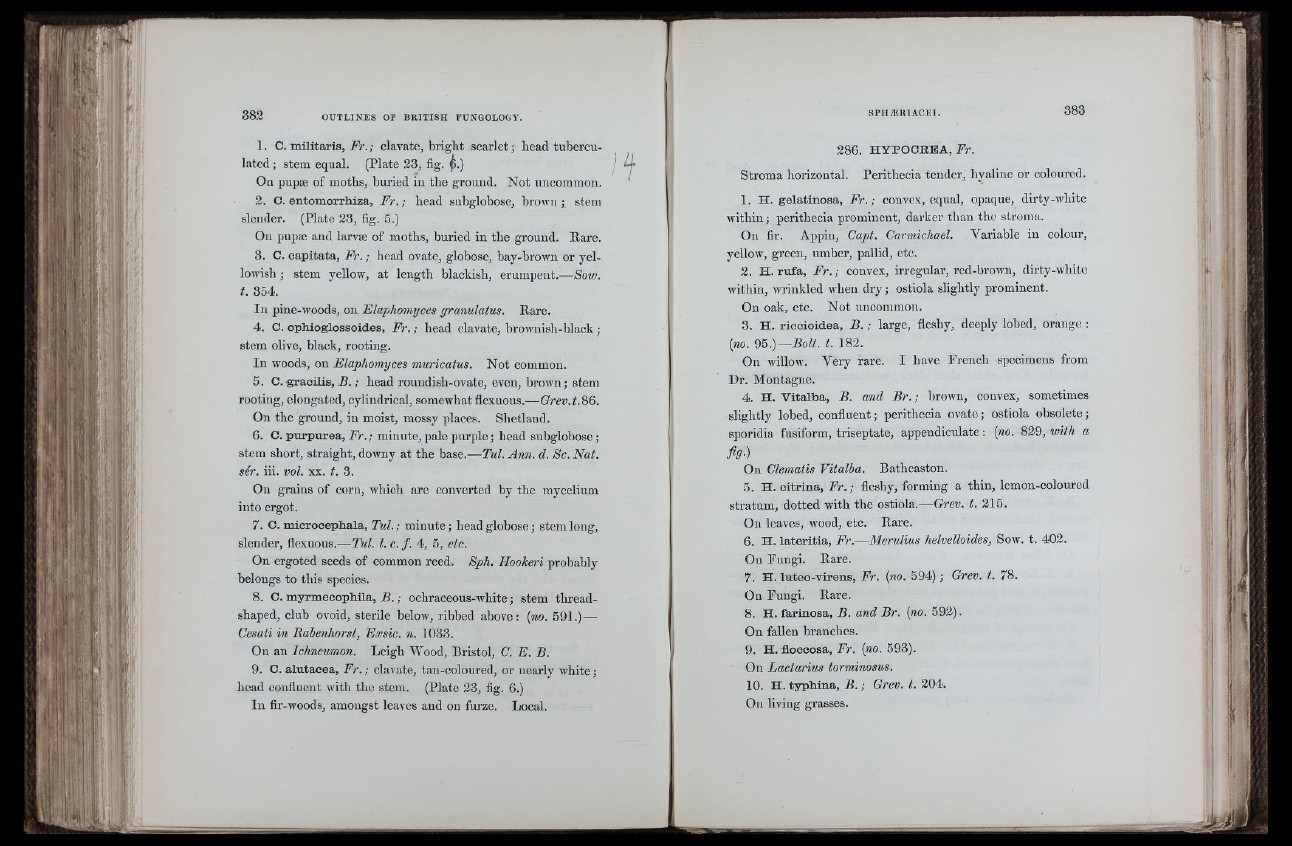
>1
i - J
1. C. militaris, R?-.; clavate, bright scarlet; head tubercu-
lated; stem equal. (Plate 23, fig. ^.)
On pupse of moths, buried in the ground. Not uncommon.
2. C. entomorrhiza, F r .; head subglobose, brown; stem
slender. (Plate 23, fig. 5.)
On pupae and larvae of moths, buried in the ground. Eare.
3. C. eapitata, F r .; head ovate, globose, hay-brown or yellowish
; stem yellow, at length blackish, erumpent.—Sow.
t. 354.
In pine-woods, on Elaphomyces granulatus. Rare.
4. C. ophioglossoides, F r .; head clavate, brownish-black;
stem olive, black, rooting.
In woods, on Elaphomyces muricatus. Not common.
5. C. gracilis, S . ; head roundish-ovate, even, brown; stem
rooting, elongated, cylindrical, somewhat flexuous.—Grev. t.36.
On the ground, in moist, mossy places. Shetland.
6. C. purpurea, Fr.; minute, pale purple; head subglobose;
stem short, straight, downy at the base.—Tul. Ann. d. Sc. Nat.
ser. iii. vol. xx. t. 3.
On grains of corn, which are converted by the mycelium
into ergot.
7. C. mioroeephala, Tul.; minute; head globose; stem long,
slender, flexuous.—Tul. I. c .f. 4, 5, etc.
On ergoted seeds of common reed. Sph. Hookeri probably
belongs to this species.
8. C. myrmeoophila, R .; ochraceous-white; stem thread-
shaped, club ovoid, sterile below, ribbed above: {no. 591.) —
Cesati in Rabenhorst, Exsic. n. 1033.
On an Ichneumon. Leigh Wood, Bristol, C. E. B.
9. C. alutacea, F r .; clavate, tan-coloured, or nearly white;
head confluent with the stem. (Plate 23, fig. 6.)
In fir-woods, amongst leaves aud on furze. Local.
286. HYPOCREA, Rr.
Stroma horizontal. Perithecia tender, hyaline or coloured.
1. H. gelatinosa, F r .; convex, equal, opaque, dirty-white
within; perithecia prominent, darker than the stroma.
On fir. Appin, Capt. Carmichael. Variable in colour,
yellow, green, umber, pallid, etc.
2. H. rufa, F r .; convex, irregular, red-brown, dirty-white
within, wrinkled when d ry ; ostiola slightly prominent.
On oak, etc. Not uncommon.
3. H. riccioidea, R . ; large, fleshy, deeply lohed, orange :
{no. 95.)—Bolt. t. 182.
On willow. Very rare. I have French specimens from
Dr. Montague.
4. H. Vitalba, R. and B r .; brown, convex, sometimes
slightly lohed, confluent; perithecia ovate; ostiola obsolete;
sporidia fusiform, triseptate, appendiculate: {no. 829, with a
fig-)O
n Clematis Vitalba. Batheaston.
5. H. citrina, F r .; fleshy, forming a thin, lemon-coloured
stratum, dotted with the ostiola.—Grev. t. 215.
On leaves, wood, etc. Rare.
6. H. lateritia, Fr.—Merulius helvelloides, Sow. t. 402.
On Fungi. Rare.
7. H. luteo-virens, Fr. {no. 594); Grev. t. 73.
On Fungi. Rare.
8. H. farinosa, R. and Br. {no. 592).
On fallen branches.
9. H. flocoosa, Fr. {no. 593).
On Lactarius torminosus.
10. H. typhina, R . ; Grev. t. 204.
On living grasses.
f: -j; I
il
V'. M'I
il